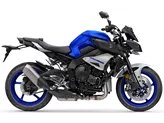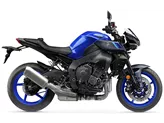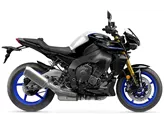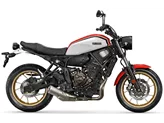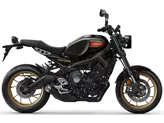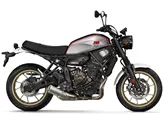Yamaha MT-10 2017 vs. Yamaha XSR900 2016

Yamaha MT-10 2017

Yamaha XSR900 2016
Overview - Yamaha MT-10 2017 vs Yamaha XSR900 2016
The Yamaha MT-10 2017 and the Yamaha XSR900 2016 are both naked bikes from Yamaha, but they have some key differences in terms of technical specifications and strengths.
Starting with the technical specifications, the Yamaha MT-10 2017 is equipped with a more powerful engine compared to the Yamaha XSR900 2016. The MT-10 has an inline 4-cylinder engine with a displacement of 998cc, producing 160 horsepower and 111 Nm of torque. On the other hand, the XSR900 has an inline 3-cylinder engine with a displacement of 847cc, producing 115 horsepower and 87.5 Nm of torque. This makes the MT-10 more powerful and provides better acceleration.
Both bikes have similar suspension setups, with upside-down telescopic forks in the front and a swing arm with a monoshock in the rear. The chassis of both bikes is made of aluminum, but the MT-10 has a Deltabox frame while the XSR900 has a Twin Tube frame. The Deltabox frame on the MT-10 is known for its rigidity and stability, providing better handling and control.

Yamaha MT-10 2017
In terms of braking, both bikes have double disc brakes in the front, but the MT-10 has larger 320mm diameter discs compared to the 298mm discs on the XSR900. This gives the MT-10 better stopping power and improved braking performance.
Both bikes come with advanced rider assistance systems such as ABS and traction control. However, the XSR900 only has ABS as standard, while the MT-10 has both ABS and traction control as standard. This gives the MT-10 an advantage in terms of safety and control.
In terms of dimensions and weights, the XSR900 has a slightly longer wheelbase of 1440mm compared to the 1400mm wheelbase of the MT-10. The seat height of the XSR900 is also slightly lower at 815mm compared to the 825mm seat height of the MT-10. The XSR900 is slightly lighter with a kerb weight of 191kg compared to the 210kg kerb weight of the MT-10. However, the MT-10 has a larger fuel tank capacity of 17 liters compared to the 14 liters of the XSR900.
Moving on to the strengths of each bike, the MT-10 is praised for its great sound, pleasant wind protection, and comfortable seating position even on long tours. It also has a great engine response and is considered a balanced overall package despite its radical looks and wicked sound.

Yamaha XSR900 2016
On the other hand, the XSR900 is known for its greedy engine and well-tuned riding modes. It comes with ABS and traction control as standard, which is a plus for safety. The XSR900 also has an authentic modern design and clean workmanship.
However, both bikes have their weaknesses. The MT-10 has a seating position that is too inactive on the racetrack, and its chassis and ride assistance systems are not on the same level as other Powernakeds. The XSR900 has a hard chassis and the seat could be more comfortable. Additionally, the speedblock design of the XSR900 is already seen on many other Yamaha models, which may be seen as a drawback for some.
In conclusion, the Yamaha MT-10 2017 and the Yamaha XSR900 2016 are both impressive naked bikes from Yamaha. The MT-10 offers more power and better overall performance, while the XSR900 has a unique design and comes with ABS and traction control as standard. Both bikes have their strengths and weaknesses, so it ultimately comes down to personal preference and intended use.
Technical Specifications Yamaha MT-10 2017 compared to Yamaha XSR900 2016
Pros and Cons in comparison
Pros and Cons in comparison
Yamaha MT-10 2017

La Yamaha MT-10 dégage beaucoup d'émotion avec son superbe moteur CP4, mais n'en oublie pas pour autant son utilité pragmatique. Pour une nakedbike, elle offre beaucoup de confort lors des longs trajets. Elle se déplace rapidement, tout en restant cultivée à tout moment. Sur les pistes de course, le châssis n'est pas assez précis pour battre les autres Powernakeds. Mais dans l'ensemble, elle marque des points grâce à sa polyvalence associée à un look radical et à un son génial.
Yamaha XSR900 2016

La XSR900 allie les performances d'un streetfighter sportif à l'esthétique d'un naked bike rétro aux finitions soignées. Pour ce faire, les Japonais se servent de leur propre histoire, qui se trouve concentrée et sans faille dans les archives de l'agence de design travaillant depuis 60 ans pour Yamaha. Elle reprend les vertus de la MT-09 et a corrigé quelques-unes de ses faiblesses. Elle se conduit de manière plus harmonieuse, plus contrôlée et, si on le souhaite, plus détendue. Seul le confort, et donc le pilote, souffre de la fermeté du châssis sur les mauvaises routes. Il faut être capable de souffrir un tout petit peu avec un néo-classique.
Price Comparison Avarage Market Price Yamaha MT-10 vs Yamaha XSR900
There are a few key differences between a Yamaha MT-10 2017 and a Yamaha XSR900 2016. In terms of price, the actual average price of a Yamaha MT-10 2017 is about 54% higher. A Yamaha MT-10 2017 experiences a loss of 1,000 USD in one year and 1,680 USD in two years of ownership. This is offset by a loss of 1,650 USD and 1,670 USD for a Yamaha XSR900 2016. Compared to Yamaha XSR900 2016 there are more Yamaha MT-10 2017 bikes available on the 1000PS.de Marketplace, specifically 12 compared to 5. It takes less time to sell a Yamaha XSR900 with 77 days compared to 143 days for the Yamaha MT-10. Since model year 2016 1000PS.de editors have written 32 reviews for the Yamaha MT-10 and 30 reviews for the Yamaha XSR900 since model year 2016. The first review for the Yamaha MT-10 was published on 11/17/2015 and now has more than 20,700 views. This compares to more than 17,600 views for the first review on Yamaha XSR900 published on 11/25/2015.







